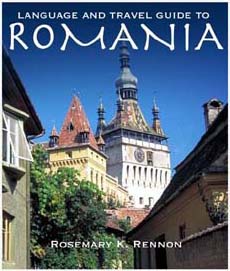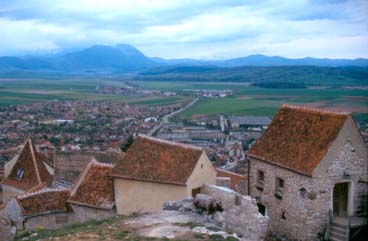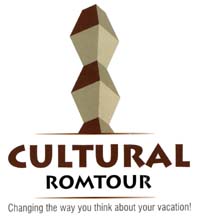 A World of Adventure
A World of Adventure
 A World of Adventure
A World of Adventure
|
| BUCHAREST | WALLACHIA | TRANSYLVANIA | MOLDAVIA | MARAMURES | CRISANA & BANAT | THE BLACK SEA | DANUBE DELTA |
at Amazon.com  For details and addresses of Transylvania's medieval cities, unique architecture, citadels, castles, villages, and countryside, plus hotels, transportation, and tours, get the new Language and Travel Guide to Romania published by Hippocrene Books.
|
TRANSYLVANIAThe most famous area in Romania, thanks to the legend of Dracula, this is a picturesque region of medieval towns and hilly pastures nestled among the Carpathian mountains in the center of the country. Its name inspires romantic visions of mountain forests, imposing castles and a mysterious history.While under Hungarian rule in the 13th century, Transylvania was settled by Saxons invited by King Geza II. They brought with them an advanced civilization and built seven fortified towns in the region, which became known as the Siebenburgen (seven fortresses). Sadly, most of the ethnic Germans fled Romania during Ceausescu's communist rule or immediately thereafter, but their influence is still dominant in the region. Likewise, German is the most common language spoken after Romanian in Transylvania, followed by Hungarian. Few people speak English here.
Nestled at the foot of Mount Timpa, Brasov is Romania's second most important city. An industrial center with over 323,000 inhabitants, Brasov's old section is a picturesque relic of its historic beginning. Settled by Saxons as one of their Siebenburgen (the town was then called Kronstadt), the architecture of Old Brasov is distinctively Germanic. Colorfully painted and ornately trimmed buildings line the streets.
The 14th century gothic Black Church, so named after blackened by smoke by a fire in 1689. Strada Republicii, a pedestrians-only street lined with shops and colorful old Saxon buildings. A memorial gravesite park honoring the people (mostly students) who died during the December 1989 revolution; each with a photograph of the person's age. Parc Central, with a rose garden, promenade and a children's playground. Mount Timpa, overlooking town; a cable car runs to the summit and lookout point; Panoramic restaurant and outdoor cafe at top.
Remains of the 15th century fortress wall, built to protect against Turkish invasion.
Brasov’s only Synagogue, built in 1901, and the Schei Gate, entry to the Schei district. Dealul Cetatii, Citadel Hill, topped by well-preserved ruins of 14th century citadel, now a restaurant 13th century gothic Church of St. Bartholomew at the foot St. Jacob’s Hill, where Vlad Tepes impaled his victims in 1460. Bran and Rasnov  Bran Castle, medieval fortress most often associated with the legend of Dracula, built in 1377 atop a hill to protect Brasov from invading Hungarians and Turks.
Bran Castle, medieval fortress most often associated with the legend of Dracula, built in 1377 atop a hill to protect Brasov from invading Hungarians and Turks. Rasnov, ruins of the 14th century peasant fortress on a hill and its fortress walls, bastion, well and houses. A 15 mile (25 km.) bus ride from Brasov stops at both villages.
Sighisoara
Across from the Clock Tower is the 13th century Monastery Church, decorated with hanging oriental rugs, a baroque altar and a bronze font from 1440. The streets are lined with charming old houses painted yellow, blue, green, and pink. Especially interesting are the 16th century Venetian House, the 17th century House with Deer and the 18th century Schuller House.
The Covered Stairway, erected in 1656, has 175 steps leading up the hill from Strada Scolii; it is covered by a pointed wooden roof and sides loosely slatted to let in light. At the top of this hill stand the 14th century schoolhouse, still in use, and the Church on the Hill (Bergkirch) built in 1309.
Piata Hermann Oberth, heart of the lower town, has a little park filled with flowers and surrounded by colorful medieval houses, shops and cafes. It connects to the hill via an ancient cobblestone path, Strada Turnului, leading underneath the Clock Tower.
The white Byzantine style Orthodox Cathedral is north of the citadel, overlooking the river.
Sibiu
Its most famous building is the 200 year old Imparatul Romanilor Hotel, which housed Emperor Franz Joseph II of the Austro-Hungarian Empire, Franz Liszt, Johann Strauss, Johannes Brahms and poet Mihail Eminescu.
Another clock tower tops the 18th-century Catholic Cathedral with its interior of pink marble colonnades, gold-laced walls, and ceiling frescoes.
Brukenthal Palace Museum, the Baroque style home of Samuel von Brukenthal, governor of Transylvania from 1777-1787, now displays paintings, graphics, engravings and sculptures from the 15th-19th centuries. It also has history and natural science sections, folk art and a library with priceless early books and old Transylvanian newspapers.
Piata Huet's gothic Evangelical Church (Lutheran), built during the 14th-16th centuries as a Catholic basilica, contains the tomb of Mihnea the Bad, the son of Vlad Tepes.
The ancient Passage of Steps narrowly connects Piata Huet with Strada Turnului in the lower town, along a medieval wall with brick and tiled overhead arches.
Piata Mica has the arcaded Old Market Hall museum, built in 1789, and connects to the 1850 Iron Bridge, also called Liars Bridge. Legend says that no one can tell a lie while standing on it without the bridge collapsing. Alongside is Fingerling's Ladder, a steep staircase that leading from the lower town's artisan area up to Piata Mica.
Old Town Hall, built 1470-1491, is now the History Museum.
The Orthodox Metropolitan Cathedral, was built in 1906 to resemble Istanbul's Hagia Sofia.
Sibiu, the former Hermannstadt, was a major trading center between Transylvania and Wallachia. To protect the town against Turkish invasion, its 15th century guilds built a fortified brick wall with 40 bastions around the city. Along Strada Cetatii stands the best preserved stretch of the wall and three red-roofed bastions. A narrow park lines the high ground inside the wall; steps lead down to its arched doorway to the low ground outside the walls, where modern Sibiu resides.
Cluj-Napoca
The town center is Piata Unirii, dominated by St. Michael's Catholic church,
The Art Museum in the 18th century Bamfly mansion, with collections of weaponry, carpets,
The Ethnographic Museum of Transylvania, housed in an 18th century palace where Hungarian Franz Liszt performed, holds Romanian traditional costumes, textiles, pottery, tools, photographs and documents.
An open-air branch of the museum on Hoia Hill consists of peasant houses and wooden churches from the region.
Babes-Bolyai University at Piata Pacii and beyond, holds the students' club and medical faculty.
The Botanical Gardens is 35 acres with plants from all over the world, greenhouses with subtropical plants and succulents, an aquarium with the Amazon lily, and a Japanese garden.
|
 www.CulturalRomtour.com
|